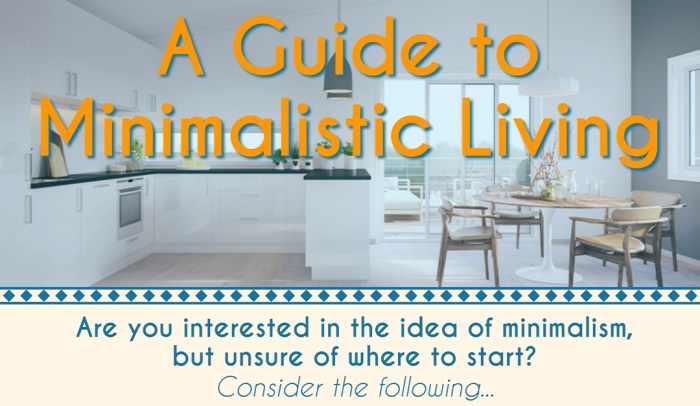The Ultimate Minimalist Living Guide: Embracing Simplicity for a Fulfilling Life

The minimalist living guide sets the stage for this enthralling narrative, offering readers a glimpse into a story that is rich in detail and brimming with originality from the outset. From defining minimalist living to exploring its benefits and impact on mental well-being, this guide delves deep into the essence of simplicity and intentional living.
As we navigate through the realms of decluttering, organization, minimalist home design, and building a minimalist wardrobe, the path to a more intentional and fulfilling life becomes clearer with each step taken towards minimalism.
Introduction to Minimalist Living
Minimalist living is a lifestyle focused on living with less, prioritizing quality over quantity, and reducing clutter in both physical and mental spaces. The core principles of minimalist living include intentional consumption, decluttering, and simplifying daily routines.
By adopting a minimalist lifestyle, individuals can experience various benefits such as reduced stress, increased focus, improved creativity, and enhanced overall well-being. Minimalist living encourages mindfulness, gratitude, and a deeper connection to the present moment.
Benefits of Minimalist Living
- Less stress: With fewer possessions and distractions, there is less to worry about and manage, leading to reduced stress levels.
- Increased focus: Minimalist living allows for better focus on what truly matters, leading to improved productivity and efficiency.
- Improved mental clarity: By decluttering physical spaces, the mind can also declutter, resulting in better mental clarity and peace of mind.
Decluttering and Organization

Decluttering and organizing your living space is essential in maintaining a minimalist lifestyle. By simplifying your surroundings, you can create a sense of calm and focus in your daily life.
Effective Decluttering Strategies
- Start small: Begin decluttering one area at a time to prevent feeling overwhelmed.
- Use the KonMari method: Sort items by category and keep only those that spark joy.
- Donate or sell unused items: Clear out belongings that no longer serve a purpose in your life.
Tips for Organizing Belongings
- Utilize storage solutions: Invest in bins, baskets, and shelves to keep items organized.
- Create designated spaces: Assign specific areas for different categories of items to maintain order.
- Develop a daily routine: Spend a few minutes each day tidying up to prevent clutter from accumulating.
Impact of a Clutter-Free Space
Maintaining a clutter-free environment can have a significant impact on your productivity and mental clarity. A tidy space allows you to focus on tasks at hand without distractions, leading to increased efficiency and reduced stress levels.
Minimalist Home Design
Minimalist home design focuses on simplicity, functionality, and the use of clean lines. It involves reducing clutter and only keeping essential items to create a clean and calming space. Key elements of minimalist home design include:
Limited color palette
Minimalist homes often feature neutral colors like white, beige, gray, or black to create a sense of calm and simplicity.
Functional furniture
Furniture pieces are typically simple, with clean lines and multifunctional designs to maximize space and minimize clutter
Negative space
Minimalist design emphasizes open spaces and avoids overcrowding rooms with unnecessary decor or furniture.
Natural light
Large windows and minimal window treatments are commonly used to bring in natural light and create a sense of openness.
Minimal decor
Decor items are carefully selected and kept to a minimum to avoid visual clutter.
Comparison with Other Interior Design Styles
When compared to other interior design styles like traditional, modern, or eclectic, minimalist design stands out for its simplicity and focus on essentials. While traditional design tends to be more ornate and detailed, minimalist design prioritizes clean lines and open spaces.
Modern design may share some similarities with minimalist design in terms of simplicity, but minimalist design takes it a step further by eliminating excess furniture and decor. Eclectic design, on the other hand, mixes different styles and elements, resulting in a more personalized and unique look compared to the uniformity of minimalist design.
Examples of Minimalist Furniture and Decor
- Minimalist sofa: A sleek, simple sofa with clean lines and neutral upholstery.
- Minimalist dining table: A minimalist dining table made of wood or metal with a simple design and no unnecessary embellishments.
- Minimalist lighting fixtures: Minimalist pendant lights or floor lamps with clean, geometric shapes and neutral finishes.
- Minimalist wall art: Abstract or minimalist art pieces that complement the clean aesthetic of a minimalist space.
Minimalist Wardrobe

Having a minimalist wardrobe is all about simplifying your clothing collection to only include items that you truly love and wear regularly. By adopting this approach, you can experience a range of benefits such as reduced decision fatigue, increased clarity in personal style, and a more organized living space.
Benefits of a Minimalist Wardrobe
- Less clutter and easier organization in your closet
- Save time getting dressed each day
- Increased focus on quality over quantity
- Reduced impulse buying and unnecessary spending
Tips for Creating a Versatile Minimalist Wardrobe
- Start by decluttering your current wardrobe and only keep items you truly love and wear often
- Invest in high-quality basics that can be mixed and matched easily
- Choose a color palette that works well together to create cohesive outfits
- Aim for a capsule wardrobe with a limited number of pieces for each season
Simplifying Daily Routines with a Minimalist Wardrobe
By streamlining your clothing collection, you can simplify your daily routines in various ways. With fewer choices to make, you can save time getting dressed in the morning and focus on other priorities throughout the day. Additionally, a minimalist wardrobe encourages a more intentional approach to fashion, helping you cultivate a personal style that truly reflects who you are.
Final Wrap-Up
In conclusion, the minimalist living guide encapsulates the essence of intentional living, urging individuals to embrace simplicity and mindfulness in every aspect of their lives. By decluttering spaces, designing homes with minimalism in mind, and curating wardrobes that reflect simplicity, one can pave the way for a more purposeful and fulfilling existence.
Clarifying Questions
How can minimalist living improve mental well-being?
Minimalist living can reduce stress and anxiety by promoting a clutter-free environment that fosters peace and clarity of mind.
What are some key elements of minimalist home design?
Key elements include clean lines, minimal furniture, neutral colors, and a focus on functionality.
How can I create a versatile and minimalist clothing collection?
Focus on quality over quantity, choose versatile pieces, and aim for a color-coordinated wardrobe for easy mix-and-match options.

